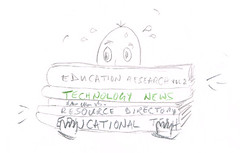 In this series I’m going to be making some suggestions, putting out some ideas. These are based on presentations I’ve given. I can think of how these ideas, or their implications, might be applied in the classroom. However, I think it better if I stand back and let you do that part of the work!
In this series I’m going to be making some suggestions, putting out some ideas. These are based on presentations I’ve given. I can think of how these ideas, or their implications, might be applied in the classroom. However, I think it better if I stand back and let you do that part of the work!
There’s a really good chance that in some schools, or in some classes, the computing curriculum will be just as boring as the old ICT curriculum was accused of being. I think the basic starting point for any scheme of work should be a simple proposition: using technology is mostly enjoyable. It can also be exciting. Therefore, learning about technology should be equally enjoyable and exciting. If it isn’t, something is wrong.
An example of technology being enjoyable is the ‘Hello Lamp Post’ project that ran in Bristol in 2013. This took advantage of the fact that every item of street furniture – fire hydrants, bus stops and lamp posts – have a unique identifier. You can test this for yourself if you live in a city that uses something like the Next Bus service. In the picture shown, the number of the bus stop is 55056, so by texting that number to the service provider you receive a text message telling you when the next bus is due.
In the Bristol project, people could send a text message to, say, a lamp post and receive a reply – seemingly from the lamppost! Of course, the replies came from a cloud-based service – Twilio, in fact.
Here’s a short video showing the project in action, and you can find out more about the project by visiting the Hello Lamp Post website.
Hello Lamp Post from PAN Studio on Vimeo.
Then consider the following:
- How could you use this sort of idea in your lessons?
- Could you use this project as a basis for theoretical work in the curriculum?
- Might the project inspire some students to become more interested in computing?
 Your newsletter editor is hard at work doing research for Digital Education, the free newsletter for education professionals. Have you subscribed yet?
Your newsletter editor is hard at work doing research for Digital Education, the free newsletter for education professionals. Have you subscribed yet?
Read more about it, and subscribe, on the Newsletter page of the ICT in Education website.
We use a double opt-in system, and you won’t get spammed.

